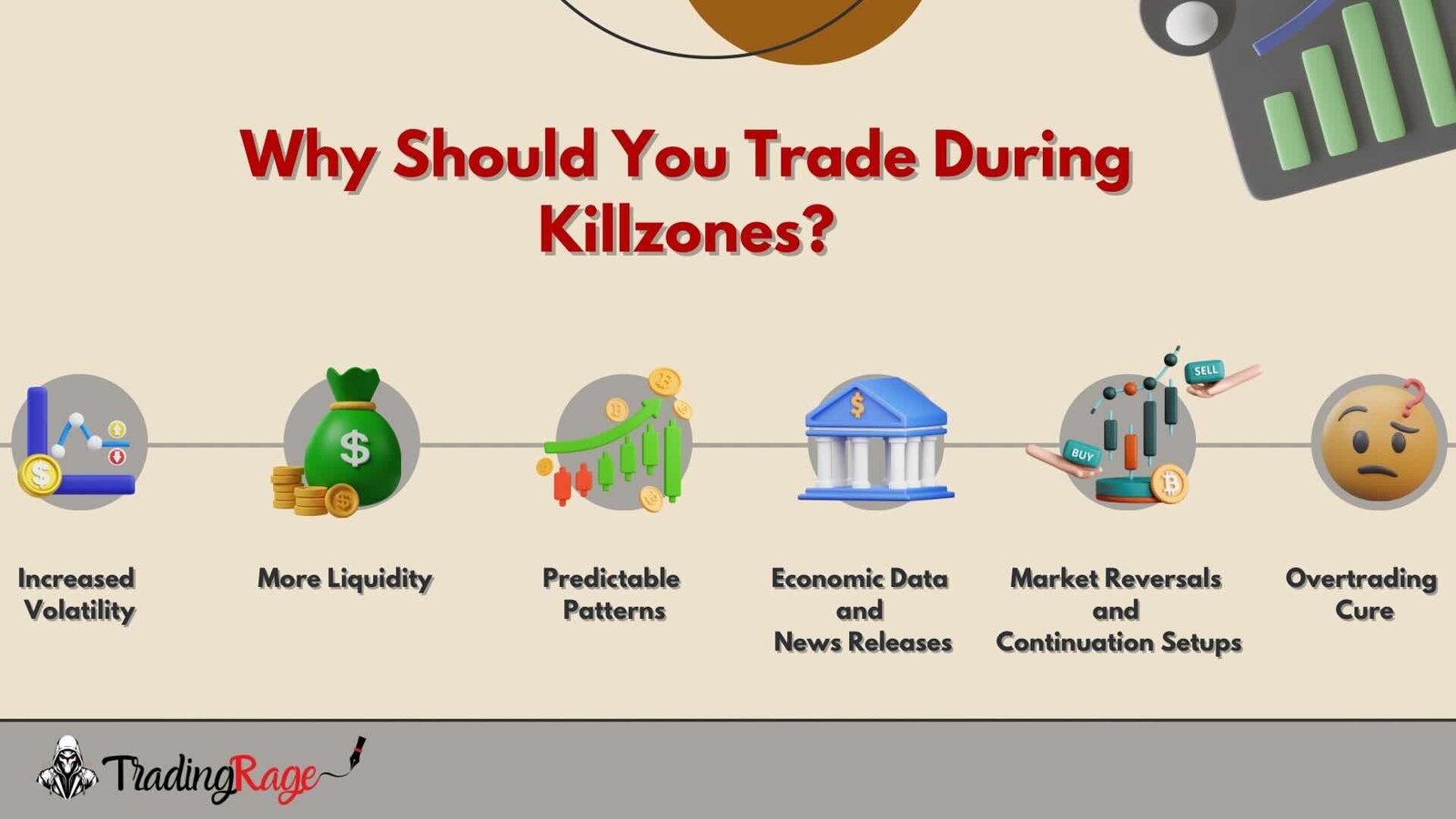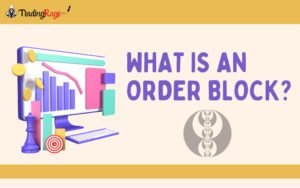Last Update: October 13, 2024
As the Inner Circle Trader himself claims, ICT trading concepts focus on two primary elements: price and time. While many traders primarily focus on price action, after years of trading ICT strategies, I’ve realized that time is as important as price, if not more, as it is used in many ICT models like the Power of 3. In this article, I’ll talk about ICT Killzones, which are times of day when the market is most volatile.
ICT Killzones are essentially embedded in each trading session, so they’re different from market sessions. I’ll begin the article by explaining the basic idea behind ICT kill zones and then present the ICT Killzone times for each session. I will also provide some examples for you to see how trading during ICT Kill zones can boost your profitability.
Key Takeaways
Trading during ICT Kill Zones significantly increases the probability of both finding good setups and winning trades. This is because the market is more volatile and likely to trend during these hours*. So, as an intraday ICT trader, you can limit your trades to the ICT Kill Zone times.
ICT London Killzone – 2:00 to 5:00 AM NY Time / 7:00 to 10:00 AM GMT
- Best for trading major forex pairs of a European currency and the US Dollar (like EUR/USD and GBP/USD).
- The main liquidity levels to watch for are Asian session highs and lows and the previous day’s highs and lows.
- The price action during the ICT London Kill Zone time usually indicates the daily direction.
ICT New York Killzone – 7:00 to 10:00 AM for forex (12:00 to 15:00 GMT) and 8:30 to 11 AM for indices (13:30 to 16:00 GMT)
- Best for major forex pairs and stock indices (like EUR/USD and S&P500).
- The main liquidity levels to watch for are London session highs and lows and the previous day’s highs and lows.
- The price action during the ICT New York Kill Zone time is usually a continuation of the London Kill Zone.
ICT Asian Killzone – 8:00 to 10:00 PM (1:00 to 3:00 AM GMT)
- Best for trading forex pairs of Oceania and Asian currencies like AUD, NZD, and JPY.
- The US dollar usually consolidates during this period, as do other currencies and Western markets.
- The Asian kill zone sometimes forms the high or low of the day.
* Note that all of the times in this article are in the New York time zone.
What Are ICT Killzones?
ICT Killzones are times of the day when the Inner Circle Trader recommends traders execute their positions. During these times, the probability of winning trades based on ICT concepts is much higher because the markets are most volatile. Again, ICT claims that during Killzones, market algorithms begin efficient price delivery to predetermined levels.
While you can argue about the last sentence, many ICT traders, including myself, have seen how, during ICT Killzones, the price is much quicker to reach its target. This is, of course, because of the heightened levels of volatility in these time periods.

ICT Killzones Times for Intraday Trading
As already mentioned, ICT Kill zone times are divided between different market sessions. So, there are three primary Killzone times, which I personally use the first two only:
- ICT London Killzone time
- ICT New York Killzone time
- ICT Asian Killzone time
| ICT Killzone | EST (New York) Timezone | GMT Timezone | UTC Timezone | Best for |
|---|---|---|---|---|
| ICT London Killzone | 2:00 – 5:00 | 7:00 – 10:00 | 6:00 – 9:00 | Major forex pairs of a European currency and the US Dollar |
| ICT New York Killzone (Forex) | 7:00 – 10:00 | 12:00 – 15:00 | 11:00 – 14:00 | Major forex pairs |
| ICT New York Killzone (Indices) | 8:30 – 11:00 | 13:30 – 16:00 | 12:30 – 15:00 | US Stock Indices |
| ICT Asian Killzone | 20:00 – 22:00 | 1:00 – 3:00 | 0:00 – 2:00 | Forex pairs of Oceania and Asian currencies |
I will explain each one in detail.
ICT London Killzone time
The ICT London Killzone that I trade is from 2 to 5 AM in the New York timezone. During this time, the London session opens, and the London Kill zone covers the session’s beginning hours.
While it might not be the most volatile timeframe during the London session, it offers some clean trading setups that I take almost every day. Yet, I primarily trade forex pairs during this Killzone, primarily EUR/USD and GBP/USD.
ICT New York Killzone time
The next ICT Killzone of the day is the New York Kill zone. The ICT NY Killzone is different for indices and forex pairs. Here’s the breakdown:
- ICT Indices Killzone: 8:30 – 11 AM New York time
- Best for Nasdaq100 and S&P500 indices
- The New York equities open at 9:30 AM is also a key time
- ICT Forex Killzones: 7 – 10 AM New York time
- Best for major currency pairs like EUR/USD and GBP/USD
- The 8:30 AM New York opening is a key time as most economic news releases at this time
So, if you want to trade the Nasdaq 100 index on either futures or CFDs, you should execute between 8:30 to 11 in the New York timezone. Moreover, for trading pairs like EUR/USD, you should trade between 7 and 10 AM New York time.
ICT Asian Killzone time
Finally, we’ll talk about the ICT Asian Killzone. While I don’t personally trade the ICT Asian Kill zone, I know traders who do, and they execute their orders from 8 to 10 PM in the New York timezone.
However, according to my own experience from looking at charts for the last 5 years, the ICT Asian Killzone time is best for JPY, NZD, and AUD pairs.
Why Should You Trade During Killzones?
Trading during the ICT Killzones has many perks, and we’ve already mentioned some that are related to market conditions. However, there are also some psychological benefits to keeping your trading time limited to ICT Kill zones. So, here’s an overview of the pros:

Increased Volatility
ICT Kill zones typically align with the opening of financial markets in various locations like London, New York, and Tokyo. During these periods, the influx of orders by major players increases the volatility significantly. Therefore, there are bigger price moves that you can capitalize on as an ICT trader.
More Liquidity
During ICT killzones, market liquidity tends to be higher due to primary market-making algorithms becoming active. If you have enough experience in trading, you’ll know how heightened liquidity decreases slippage and spread, two very influential factors in determining a day trade’s risk-reward ratio and even win probability.
Predictable Patterns
ICT killzones are based on historical data and market behavior. There are some predictable patterns that reoccur during these time periods, like the Judas swing. I suggest you study the price’s behavior during ICT kill zones to witness these patterns for yourself.
Economic Data and News Releases
Economic news and data releases often occur during ICT Kill zones. Almost every trader knows the fact that these news releases are the primary drivers of market movements toward specific points of liquidity, and could be used for excellent trade setups.
Market Reversals and Continuation Setups
ICT Killzones often coincide with times when market reversals or continuations materialize. Analyzing the charts during the Killzones can help you identify typical ICT trade setups.
Overtrading Cure
Trading during the ICT kill zone times allows you to focus on specific times of the day only. We all know how everyone can get emotional and make irrational executions or over trade by staring at the charts all day long.

How to Specify ICT Killzones on TradingView?
To show the ICT Killzones on your charts, you can either do it manually or automatically. However, the first step is to change your TradingView timezone to New York time. Then, you can use the hours I mentioned earlier to draw vertical lines or boxes to specify the ICT Kill zone times.

An alternative and automatic way that I personally use is by implementing an indicator. Just go to the TradingView indicators menu and search the term “ICT Killzones.” There are several ICT Kill zone indicators TradingView users have created. You can choose the one that suits you well.

ICT Trade Examples During Killzones
To wrap up this article, I’ll show you some of my own trades taken during the London and New York killzones. This will make our guide to ICT killzones much more practical. So, let’s get down to it.
ICT London Killzone Trades
During the ICT London Killzone, which is from 2 to 5 AM (New York timezone), I primarily look for a hunt of the Asian session highs or lows. Then, I’ll look for a displacement and market structure shift in the other direction. Finally, I’ll enter a trade on a PD array like an ICT Fair Value Gap, Order Block, or Breaker.
Here’s an example of a trade on EUR/USD during the ICT London Killzone:

ICT New York Killzone Trades
For the ICT New York Killzone time, I’ll show two trade examples, one on the EUR/USD pair and one on the NAS100/USD, to cover both forex and indices.
Forex Trade Example
In order to trade forex during the ICT NY Killzone, I’ll only execute any valid setup I see during the 7-10 AM period (New York Timezone). For a liquidity hunt, I use any significant recent highs or lows or even the highs and lows of Asia and London sessions. The rest is the same, as I look for shifts in market structure and PD arrays for entry and exits.
Take a look at the EUR/USD trade below during the ICT New York Killzone for forex pairs:

Indices Trade Example
The process is essentially similar for indices; the only difference is the ICT indices Killzone time, which is from 8:30 to 11 AM. Meanwhile, the 9:30 AM US equities open also usually introduces high volatility. So, if you are not careful, you can get stop hunted. A solution would, of course, be trading after 9:30 AM.
Here’ the example for a NAS100/USD CFD trade in the ICT New York Killzone for indices:

ICT Asian Killzone Trades
While I personally don’t trade during the ICT Asian Killzone time, some good trading setups are present on Japanese Yen, Australian Dollar, and New Zealand Dollar pairs. As the process is pretty much the same, I won’t bother you with repeating any details.
The screenshot below shows a trade during the ICT Asian Killzone time on the USD/JPY pair:

For more ICT trade examples, check out my ICT trades journal, which I update frequently with new profitable trades I take.
Conclusion
In this article, I’ve talked about one of the primary elements in ICT trading concepts: time. Specifically, the time you should trade, as the Inner Circle Trader himself calls them, are ICT killzones. ICT traders use various killzones. However, I presented the ones I mainly use in this article, and I also recommend you give them a try on a demo account to see whether limiting your trading to these Killzones boosts your results or not.
If you have any questions, feel free to ask them in the comment section or send an email via the Contact page.
Disclaimer: All the information in this post is for educational purposes only and should not be considered investment advice. Trading in the financial markets is a high-risk endeavor. So, make sure to protect your capital at all times.





An interesting topic and I’m glad to come across your page where I found some helpful insights.